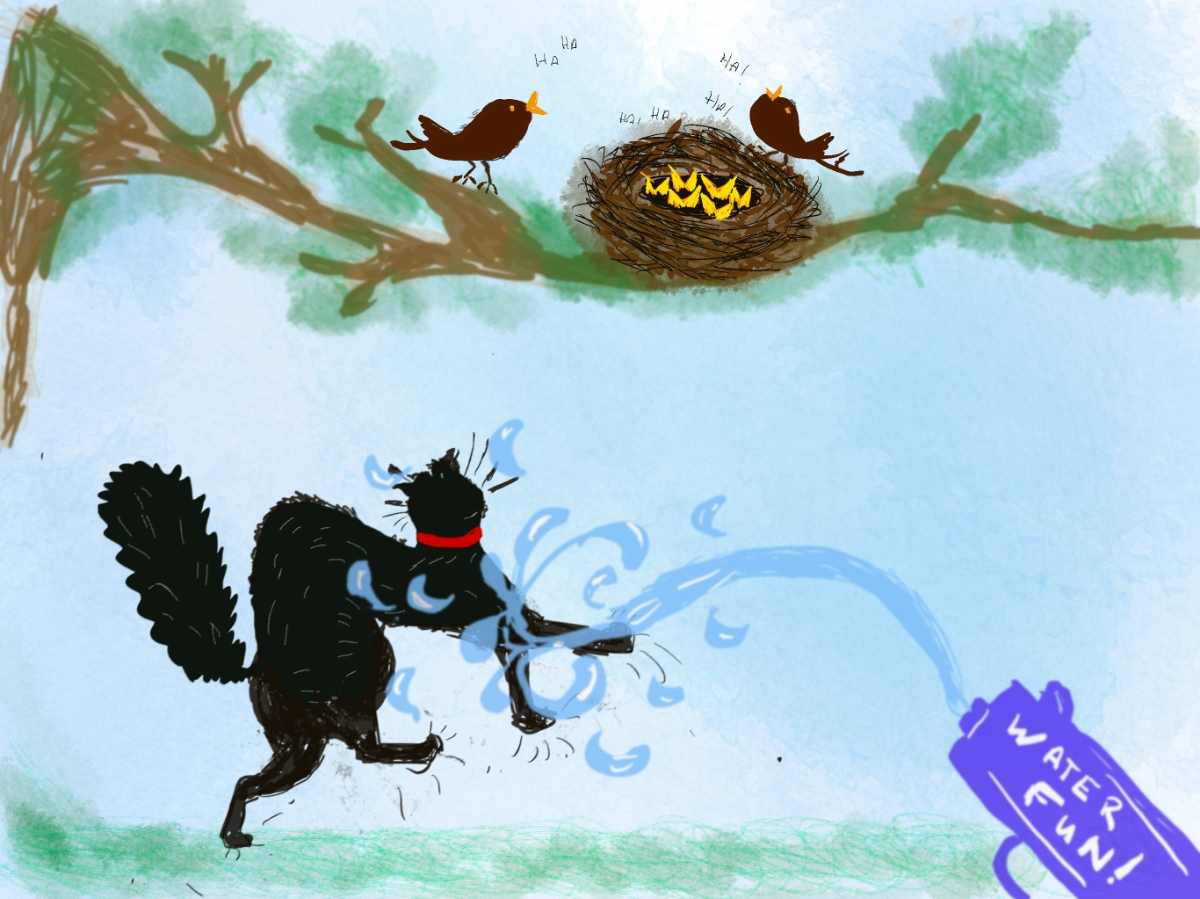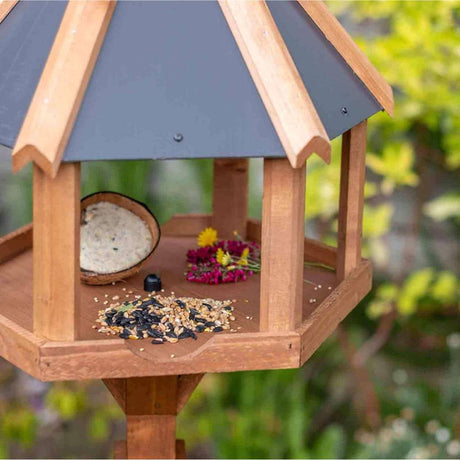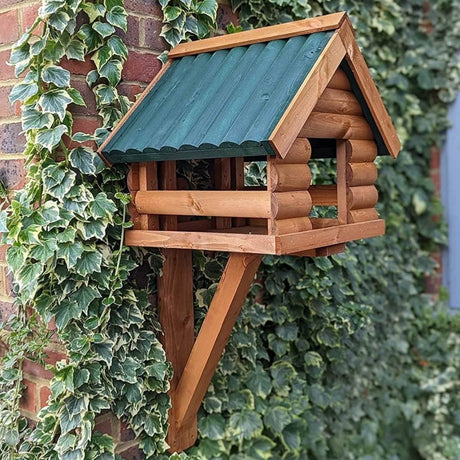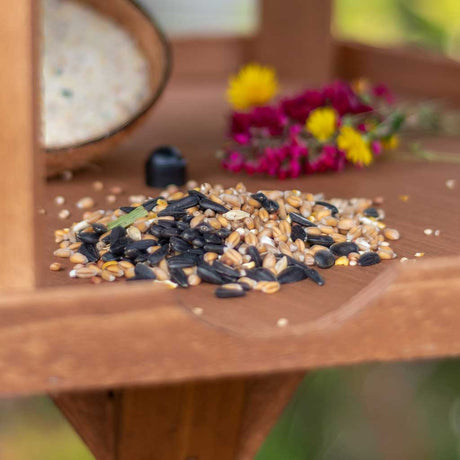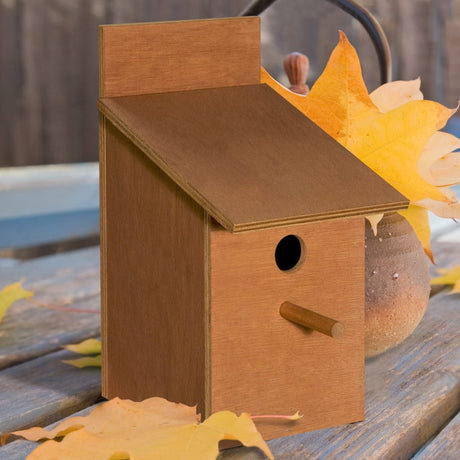How do you get wild birds into your garden? It’s simple
- provide a variety of food and do it every day.
- provide fresh water for drinking and bathing.
- provide sites for nesting.
- make sure birds in your garden are protected from predators.
Nothing beats watching birds in action in the garden: splashing in the birdbath, squabbling over food and darting in and out of the undergrowth.
And just as birds in the garden are an asset to us, our gardens are increasingly an asset to the birds. Intensive farming, the use of pesticides and the destruction of woodland and hedgerows have destroyed so much rural bird habitat that gardens are ever more important for them.
So how exactly do you attract wild birds to your garden?
There are four basic things wild birds need to survive and thrive:
- Food.
- Water.
- Nesting sites.
- Protection from predators.
If you can provide some or all of these in your garden you can be sure of attracting wild birds.
In this article we are going to look at food and drink, in part 2 we’ll cover nesting, protection and creating a bird-friendly garden.
How to Get Wild Birds To Visit Your Garden
You don’t need to be the proud owner of a safari park to make a home for wild birds. A small garden or even a large balcony can provide all the essentials they need. And the first of these is food.

Feeding Wild Birds in Your Garden
Providing a plentiful supply of food is the key to getting birds into your garden.
It may not be an instant win, you may go a couple of weeks without seeing much action on your feeders.
But birds are creatures of habit; once they realise there is food to be had in your garden they will be back each day. And once a few have started coming it always seems like they are telling their friends.
What Sort of Bird Food?

Different species of birds enjoy different types of bird food. You could spend a small fortune putting out food for all the birds that might possibly visit your garden.
But there are certain foods which are loved by a wide range of different wild birds. So these are a great place to start.Start with your store cupboard. You don’t need to head to the pet shop or garden centre to stock up on delicacies for our feathered friends.
You can make a good start at feeding with things you already have in your kitchen. Human foods loved by birds include dried fruit, cooked potatoes and rice, fat from joints of meat, grated mild cheese and unsalted nuts. This article from the RSPB has more on store cupboard bird food.
Store cupboard food is an excellent way of starting to feed birds but do be careful about the salt content. Salt can be toxic to many species of birds.
Good quality seed mix. A good quality, general-purpose seed mix should be your first bird food purchase. Good quality bird seed mix will attract sparrows, finches, robins, tits and dunnocks to name but a few. We can’t stress the “good quality” part enough.

With bird seed, you get what you pay for and a poor quality seed mix will be bulked-out with all sorts of rubbish including husks, wheat and even broken dog biscuits. These are inedible for most of our native garden birds, but very attractive to pigeons and even rats.
Fat balls and suet products. Pure animal fats like lard and beef suet provide easy-access energy for many of our wild birds. They can be used year-round but are particularly useful in the winter. Commercial fat balls and blocks are made with a mix of fat and seed mix.
You could make your own, though they’re not likely to work out much cheaper than those you can buy. Again, you get what you pay for with fat balls; if you see tubs of 50 balls for £5 they are not going to be very appetising so don’t be surprised if your local birds turn their beaks up at them.
Fruit. Blackbirds, thrushes, robins and many other species enjoy the fruit. Either soak dried fruit in a little warm water until it plumps up, or use whatever is going soggy in the fruit bowl, cut into small chunks. Our greengrocer lets us have bags of apples and pears that are damaged or old for free.
There are plenty of other types of bird food you could invest in, but this selection should be plenty to start attracting a good range of birds.

Choosing the Right Feeder
Many different species of birds are able to live happily alongside one another because they each use the environment in different ways.
Choosing the right bird feeders, choosing a range of feeders and putting them in different places will help you in attracting a wide range of different birds.
- Bird Table. The bird table provides a “stage” for your new garden visitors to come and entertain you on. Bird tables are a great option for ground-feeding birds like blackbirds, thrushes, collared doves and robins. You can put any food you choose on the platform. If you can, choose a table with a roof, this will stop your food getting soggy in the rain, and offer a little shade on hot days. If space is limited don’t worry, you can get wall-mounted bird tables, so there’s something for everyone’s outdoor space.
- Seed Feeders. Seed feeders are a staple for your garden birds and will be used by tits, house sparrows, goldfinches and siskins. They are generally too unstable to support a big fat pigeon, so help to make sure your food is getting to the smaller birds. If you are feeding Niger seed be sure to choose a specialist Niger feeder with smaller feeding holes.
- Wire Mesh Feeders. These are great for tits, sparrows, starlings and chaffinches. Fill them with peanuts and the mesh will mean that the birds can only take small chunks of the nut, not the whole thing, which might choke them or their chicks. You can also serve your fat balls in mesh feeders.
- Pole mounted feeding station. If your garden is short on places to hang your feeders, think about getting a pole-mounted feeding station. This will be home to different types of the feeder and a water dish and will cater for lots of feathered customers all in one place.
- Avoid Wire Spring Feeders. You can buy wire feeders shaped like a coiled spring for serving fat balls. We suggest you avoid these. They are quite dangerous for some birds and could easily break a leg.
You can read more on choosing the right bird feeders in this article from the Wildlife Trusts.
Be sure to keep your bird feeders clean. Birds are messy eaters and as many of them will congregate on your feeders there’s the possibility of spreading diseases. So take the feeders down and give them a good wash every few weeks.
And for more on feeding birds in your garden check out our full guide here.
Providing Water
Water is essential for birds just as it is for humans. Just like us, they need to drink and bathe.

Installing a birdbath is a sure-fire way of getting birds to visit you.
You can buy a birdbath, and many pole-mounted feeding stations come with a water dish attached.
But if you are watching your pennies don’t let that stop you. Any large shallow dish or even a plant pot saucer will do.
Birds will bathe and drink from the same dish, and probably poop in it as well. So be sure to clean your birdbath regularly.
Keeping the water topped up in winter is very important. When everything is frozen it can be difficult for birds to get a drink anywhere. And in winter bathing is especially important as it helps keep feathers in peak condition for keeping out the cold weather.
Remember to always de-ice your birdbath with building water, not salt. Salt is toxic for most birds and can kill them.
Conclusion
Providing food and water is a great first step to getting wild birds into your garden.Be patient, keep putting out food every day even if you don’t see many birds, and soon you will be rewarded with plenty of bird table action.
Once your food and water are in place the next steps are providing nesting sites and making your garden a natural haven for wild birds.
Check out part 2 to read more on nesting and bird-friendly gardening.
And in the meantime, if you have any questions or suggestions we would love to hear from you, leave us a comment below.

